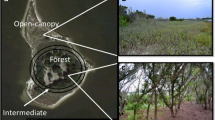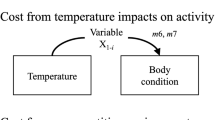Summary
Despite widespread interest in habitat selection, many of the assumptions about how territorial animals choose habitats have not been tested. This study of juvenile Anolis aeneus lizards focuses on the relationship between the number of previous settlers in a habitat and the subsequent behavior of new arrivals at that habitat. Clearings containing the types of microhabitat preferred by juveniles were established in the field, several juvenile residents were allowed to establish territories in enclosures in the center of each clearing, and then naturally occurring immigrants were allowed access to the empty microhabitat surrounding the enclosures. Arrival rates and the probability of settlement were monitored on a daily basis from the day the first juveniles arrived until several days after the last juvenile had settled (=saturation). In each of seven trials, arrival rates were comparable early and late in the settlement process, and were unrelated to the degree of habitat saturation. Arrival rates did vary on a temporal basis, probably as a result of environmental factors affecting egg laying and hatching schedules, and habitats with high arrival rates saturated more quickly than those with lower arrival rates. All of the individuals arriving at the clearings did not settle, but settlers and non-settlers did not differ with respect to competitive ability, as measured by body size. The probability of settlement increased as settlement proceeded in each of seven trials, up to the day of saturation. These results refute the commonly held assumptions that prospective territory owners avoid entering relatively full habitats, and that they prefer to settle in relatively unsaturated habitats. The discussion considers why assumptions about the behavioral processes of habitat selection are so widely accepted, given the dearth of empirical information on the subject.
Similar content being viewed by others
References
Allee WC (1951) The social life of animals. Beacon, Boston
Allee WC, Emerson O, Park T, Schmidt K (1949) Principles of animal ecology. Saunders, Philadelphia
Andrews RM (1988) Demographic correlates of variable egg survival for a tropical lizard. Oecologia 76: 376–382
Assem van den (1967) Territory in the three-spined stickleback (Gasterosteus aculeatus). Behav Suppl 16: 1–164
Beletsky LD, Orians GH (1989) Familiar neighbors enhance breeding success in birds. Proc Natl Acad Sci USA 86: 7933–7936
Brown JL (1969a) The buffer effect and productivity in Tit populations. Am Nat 103: 347–354
Brown JL (1969b) Territorial behavior and population regulation in birds. Wilson Bull 81: 293–329
Buss L (1981) Group living, competition and the evolution of cooperation in a sessile invertebrate. Science 213: 1012–1014
Cody ML (1985) An introduction to habitat selection in birds. In: Cody ML (ed) Habitat selection in birds. Academic Press, New York, pp 3–53
Crisp DJ (1961) Territorial behaviour in barnacle settlement. J Exp Biol 38: 429–446
Crisp DJ (1984) Overview of research on marine invertebrate fauna, 1940–1980. In: Costlow JD, Tipper RC (eds) Marine biodeterioration: an interdisciplinary study. Naval Institute Press, Annapolis, pp 103–126
Fisher J (1954) Evolution and bird sociality. In: Huxley J, Hardy AC, Ford EB (eds) Evolution as a process. Allen and Unwin, London, pp 71–83
Fretwell SD (1972) Populations in a seasonal environment. Princeton University Press, Princeton NJ
Fretwell SD, Lucas HL (1970) On territorial behavior and other factors influencing habitat distribution in birds. I. Theoretical development. Acta Biotheoretica 19: 16–36
Getty T (1987) Dear enemies and the prisoner's dilemma: why should territorial neighbors form defensive coalitions? Am Zool 27: 229–247
Griffith B, Scott JM, Carpenter JW, Reed C (1989) Translocation as a species conservation tool: status and strategy. Science 245: 477–480
Hildén O (1965) Habitat selection in birds. Ann Zool Fenn 2: 53–75
Hill GE (1989) Late spring arrival and dull nuptial plumage: aggression avoidance by yearling males? Anim Behav 37: 655–673
Kluyver HN, Tinbergen L (1953) Territory and the regulation of density in titmice. Arch Neerl Zool 10: 265–287
Krebs JR (1977) The significance of song repertoires: the Beau Geste hypothesis. Anim Behav 25: 475–478
Lack D (1948) Notes on the ecology of the robin. Ibis 90: 252–279
Lack D (1966) Population studies in birds. Clarendon Press, Oxford
Morris DW (1989) Density-dependent habitat selection: testing the theory with fitness data. Evol Ecol 3: 80–94
O'Connor RJ, Fuller RJ (1985) Bird population responses to habitat. In: Taylor K, Fuller RJ (eds) Bird census and atlas studies. Proc. 8th Int. Conf. on Bird Census and Atlas Work. British Trust Ornithology, Herfordshire, pp 197–211
Orians GH (1961) Social stimulation within blackbird colonies. Condor 63: 330–337
Partridge L (1978) Habitat selection. In: Krebs JR, Davies NB (eds) Behavioral ecology: and evolutionary approach. Blackwell, Oxford, pp 351–376
Pulliam HR (1988) Sources, sinks and population regulation. Am Nat 132: 652–661
Rosenzweig ML (1985) Some theoretical aspects of habitat selection. In: Cody ML (ed) Habitat selection in birds. Academic Press, New York, pp 517–540
Seastedt TR, MacLean SF (1979) Territory size and composition in relation to resource abundance in lapwing longspurs breeding in arctic Alaska. Auk 96: 131–142
Schieck JO, Hannon SJ (1989) Breeding site fidelity in willow ptarmigan: the influence of previous reproductive success and familiarity with partner and territory. Oecologia 81: 465–472
Shields WM, Crook JR, Hebblethwaite ML, Wiles-Ehmann SS (1988) Ideal free coloniality in the swallows. In: Slobodchikoff CN (ed) The ecology of social behavior. Academic Press, San Diego, pp 189–228
Smith AT, Peacock MM (in press) Conspecific attraction and the determination of metapopulation colonization rates. Conserv Biol
Stamps JA (1975) Courtship patterns, estrus periods and reproductive condition in a lizard, Anolis aeneus. Physiol Behav 14: 531–535
Stamps JA (1976) Egg retention, rainfall and egg laying in a tropical lizard, Anolis aeneus. Copeia 1976: 759–764
Stamps JA (1978) A field study of the ontogeny of social behavior in the lizard Anolis aeneus. Behaviour 66: 1–31
Stamps JA (1983a) The relationship between ontogenctic habitat shifts, competition and predator avoidance in a juvenile lizard (Anolis aeneus). Behav Ecol Sociobiol 12: 19–33
Stamps JA (1983b) Territoriality and the defence of predator-refuges in juvenile lizards. Anim Behav 31: 857–870
Stamps JA (1984a) The growth costs of territorial overlap in a juvenile lizard (Anolis aeneus). Behav Ecol Sociobiol 15: 115–119
Stamps JA (1984b) Rank-dependent compromises between growth and predator protection in lizard dominance hierarchies. Anim Behav 32: 1101–1107
Stamps JA (1987a) The effect of familiarity with a neighborhood on territory acquisition. Behav Ecol Sociobiol 21: 273–277
Stamps JA (1987b) Conspecifics as cues to territory quality: a preference of juvenile lizards (Anolis aeneus) for previously used territories. Am Nat 129: 629–642
Stamps JA (1988) Conspecific attraction and aggregation in territorial species. Am Nat 131: 329–347
Stamps JA (1990) The effect of contender pressure on territory size and overlap in seasonally territorial species. Am Nat 135: 614–632
Stamps JA, Crews DP (1976) Seasonal changes in reproduction and social behavior in the lizard Anolis aeneus. Copeia 1976: 467–476
Stamps JA, Eason PK (1989) Relationships between spacing behavior and growth rates: a field study of lizard feeding territories. Behav Ecol Sociobiol 25: 99–107
Stamps JA, Krishnan VV (1990) The effect of settlement tactics on territory sizes. Am Nat 135: 527–546
Stamps JA, Tollestrup K (1984) Prospective resource defense in a territorial species. Am Nat 123: 99–114
Sweatman HPA (1985) The influence of adults of some coral reef fishes on larval recruitment. Ecol Monogr 55: 469–485
Wethey DS (1984) Effects of crowding on fecundity in barnacles: Semibalanus (Balanus) balanoides, Balanus glandula, and Chthamalus dalli. Can J Zool 62: 1788–1795
Whitham TG (1980) The theory of habitat selection: examined and extended using Pemphigus aphids. Am Nat 115: 449–466
Wiens JA (1985) Habitat selection in variable environments: shrubsteppe birds. In: Cody ML (ed) Habitat selection in birds. Academic Press, New York, pp 227–251
Woodin SA (1986) Settlement of infauna: larval choice? Bull Mar Sci 39: 401–407
Yasukawa K, Searcy WA (1985) Song repertoires and density assessment in red-winged blackbirds: further tests of the Beau Geste hypothesis. Behav Ecol Sociobiol 16: 171–175
Author information
Authors and Affiliations
Rights and permissions
About this article
Cite this article
Stamps, J.A. The effect of conspecifics on habitat selection in territorial species. Behav Ecol Sociobiol 28, 29–36 (1991). https://doi.org/10.1007/BF00172136
Received:
Accepted:
Issue Date:
DOI: https://doi.org/10.1007/BF00172136




